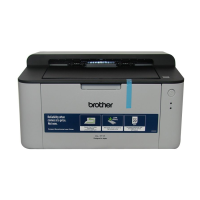CHAPTER 2 PCL - 107
8. STATUS READBACK
8.1. Introduction
Status readback features are explained in this section. The printer sends a status response message after
receiving a request for its status by these commands. You can get the information as shown below from the
printer.
- available printer (user) memory
- current available fonts and symbol sets
- the ID numbers of downloaded macros and user-defined patterns to verify their
presence
The computer system must have a device driver for bi-directional communication to get the printers status
response. Bi-directional communication is supported on the HL Series printers by the printer driver that comes
with these machines.
8.2. Memory Status request
You can identify the capacity of the user memory in the printer by using the memory status request. You can
determine whether to execute "downloading" or not, by knowing the available memory and thus avoid printer
memory overrun errors.
8.3. Entity Status
You can request the printer to send the status of its entities. A font, symbol set, macro or user-defined pattern in
the printer can be an entity. In order to request entity status, a position type and a position unit must be
identified first and then the entity request command must be sent.
Location type is the memory positions that contain the entities. Memory positions are internal ROM, RAM,
cartridges/cards, the storage device and one additional position specified as "currently selected". Currently
selected means the entity is active. However, "currently selected" can be applied only for fonts and user-defined
patterns.
Location unit means a more specific position within the location type.
When the location type and unit are identified, you can request the status with the Inquire Status Readback
Entity command. The entity (font, symbol set, macro or user-defined pattern) is specified by this command and
the printer sends the response.
When an invalid request is sent, the printer sends an error response back.
8.4. Status Response
If a status request (command) is received, the printer produces the response data. The printer accumulates this
data in an I/O status buffer and saves the response in this buffer until a user reads it or you turn off the printer.
The printer clears the status responses when Printer resolution, Page protection or Emulation language is
changed.
The printer processes status requests and their related response in the order in which the printer receives them.
According to the internal printer operations, the number of responses the printer can accumulate is different. If
you use multiple applications or share the printer, you should read the response to a request before making a
new request.
You should use the Echo command so that your applications request will synchronize with the printer's
responses, because an earlier application might have requested a status and the printer might retain it.
A status response gets routed back to the I/O port that it was requested from.

